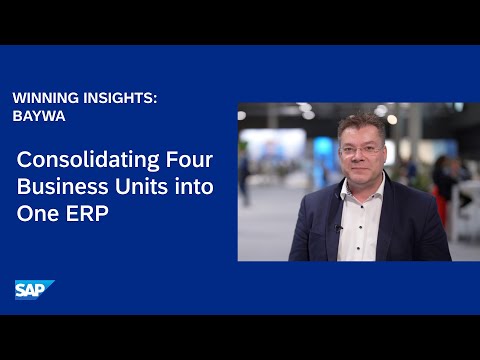Founded in Munich in 1923, BayWa AG has long been committed to meeting the essential needs of society, whether through food, warmth, housing, or mobility. In recent years, BayWa has also emerged as a leader in the renewable energy sector, showcasing the company’s broad scope and commitment to sustainable business practices.
Its efforts didn’t go unnoticed: in 2021, the United Nations and Bloomberg named BayWa one of the “50 Sustainability and Climate Leaders” worldwide, thanks largely to the company’s big push into renewable energies, which now make up more than half of BayWa’s annual earnings.
The Challenge of Transformation
BayWa’s journey with SAP began in 2000 when the company implemented the on-premise ERP system, SAP ERP Central Component (SAP ECC). However, as the business evolved it became apparent that their processes and technology could no longer keep pace. BayWa’s four business units operated in silos, which became unfeasible for a company striving to become more streamlined.
“We want to move to a process-oriented company, so that means we want to implement one ERP template,” Lars Pischke, global enterprise architect at BayWa, explains. “We have to transform all four business units into a single ERP template, which is a significant challenge.”
To address this, BayWa set out to migrate from SAP ECC to SAP S/4HANA Cloud, the foundation of its new ERP system. This transition marked a critical step toward unifying the company’s operations under one streamlined template. Additionally, BayWa implemented a digital platform, with SAP Business Technology Platform (SAP BTP) as a key component.
“A clean core strategy for BayWa means we leave our ERP solution, SAP S/4HANA Cloud, as standard, and we implement BayWa’s specific requirements on our digital platform side by side, where we rely heavily on SAP BTP as our main module,” says Pischke.
Lessons Learned and the Value of a Clean Core
The concept of a “clean core” is central to understanding the benefits of BayWa’s transition. Imagine a shared grain silo system on a farm. If each farmer keeps their grain in separate, uncoordinated silos, tracking quality, utilizing storage space efficiently, or distributing the grain becomes a cumbersome task. However, when all the grain is stored in a unified system, it becomes significantly easier to manage, access, and maintain quality. Similarly, having a clean core in business processes ensures that all parts of the organization work harmoniously, preventing inefficiencies and missed opportunities that arise from working in silos.
For BayWa, establishing a clean core was crucial. The standardized, non-differentiating functions — such as accounts payable, tax, and treasury operations — constitute approximately 75% of business processes across companies, regardless of industry, size, or location. These functions are essential but do not differentiate one company from another.
In the past, over-customization in these areas led to inflexibility and slowed down business operations. But in today’s fast-paced, competitive environment, agility is key and maintaining a clean core is vital to achieving this agility.
“Keeping the core clean is also key when it comes to security issues. BayWa is part of the critical infrastructure in Germany,” Pischke explains. “To use a standard software like SAP BTP allows us to rapidly adapt to new business models and technologies.”
Gaining a Competitive Edge with SAP BTP
With BayWa’s clean core firmly in place, the focus shifted to building a competitive edge around their operations. This is where SAP BTP comes in. The platform lets businesses create extensions and innovate in areas that really set them apart. Pischke says, “A shift toward standard also means simpler processes for our employees. This allows us to reduce training costs and speed up onboarding.” BayWa is leveraging these efficiencies to direct more resources toward innovation.
These days, companies need to know what makes them unique and lean into those strengths to stand out. While core functions are standardized and crucial for running smoothly, the elements that drive customer choice often come from the innovative, customizable features built on top of this clean core. By optimizing these standard processes, companies like BayWa can channel more energy into innovation and long-term success, keeping them ahead of the curve.
Looking Ahead: The Role of AI in BayWa’s Future
BayWa’s forward-thinking approach doesn’t stop with ERP transformation. The company is already exploring the potential of artificial intelligence (AI) to further enhance its operations.
Pischke says BayWa has started piloting AI use cases, focusing on SAP BTP’s Business AI. “We believe AI should be integrated into the applications and business processes where the data is located,” he explains. This integration is central to BayWa’s strategy, and the company has a growing list of AI use cases it plans to implement in the near future.
Attending industry events like SAP Sapphire in Barcelona provides BayWa with valuable insights into the latest technologies and trends. Pischke acknowledges the accelerating pace of technological change, noting that each year brings new ideas and innovations that could be applied within BayWa. While not every use case or SAP module is a perfect fit, these events offer inspiration and guidance for selecting the right tools to meet BayWa’s unique requirements.
Through partnership with SAP and the switch to SAP S/4HANA Cloud, BayWa has not only streamlined its operations, but also set itself up to keep leading in sustainability and innovation. The clean core approach has allowed BayWa to focus on what truly sets the company apart, helping it continue its mission to meet the essential needs of people worldwide.




